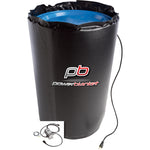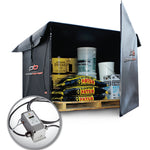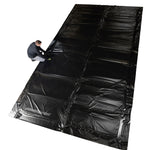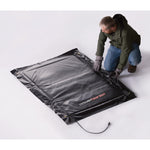You have no items in your shopping cart.
Article At-a-Glance
What Are the Key Differences Between Intrinsically Safe and Explosion-Proof Equipment?
Intrinsically safe equipment prevents ignition by limiting electrical and thermal energy to non-ignitable levels, making it ideal for high-risk environments, while explosion-proof equipment contains potential explosions within robust enclosures, suitable for areas with occasional flammable gas or vapor clouds.
Key Takeaways
- Define Core Principles: Intrinsically safe equipment limits electrical and thermal energy to prevent ignition, while explosion-proof equipment contains potential explosions within robust enclosures.
- Compare Applications: Intrinsically safe solutions are ideal for high-risk environments with constant exposure to flammable materials, whereas explosion-proof solutions suit areas with occasional flammable gas or vapor presence.
- Evaluate Design and Maintenance: Intrinsically safe devices often require less maintenance and are generally more cost-effective, while explosion-proof equipment demands stricter maintenance due to its complex enclosures.
- Consider Compliance Standards: Both types must adhere to safety standards like the National Electrical Code (NEC) and Underwriters Laboratories (UL) certifications, ensuring their efficacy in hazardous environments.
- Choose Based on Environment: Select intrinsically safe equipment for environments with continuous explosion risks, and explosion-proof equipment for areas with intermittent exposure to hazardous substances.
Intrinsically Safe vs Explosion Proof: What's the Difference?
Working safely with heaters in industrial environments often means using extra caution around flammable materials and volatile air quality. This article clarifies the key distinctions between intrinsically safe and explosion-proof solutions, which will help you maintain a secure and safety-compliant work area for your employees.

$4,645.00 USD
275 Gallon Explosion-Proof IBC Tote Heater w/ Lid Cover - C1D2T4 (120V)
Protect your workers and facility with the most reliable explosion-proof tote heaters. These heaters ensure safety while delivering top-tier performance in hazardous environments.
Intrinsically Safe vs. Explosion-Proof Environments
Whether you’re in construction, manufacturing, or research, safety is incredibly important. Working with heating elements in industrial settings, particularly those involving flammable materials or volatile environments, means potentially putting workers and materials at risk. Being able to differentiate between intrinsically safe and explosion-proof solutions is crucial. You need to know the core principles of each approach, as these will help you in selecting heating equipment that is both efficient and ensures workplace safety.
The Fundamentals of Intrinsically Safe and Explosion-Proof
What is intrinsically safe equipment?
Intrinsically safe (IS) equipment is designed to prevent an explosion altogether. It achieves this by limiting the electrical and thermal energy it generates or transmits to levels incapable of igniting a surrounding flammable atmosphere. This type of equipment is ideal for environments with a high risk of explosions, like paint booths or areas where gas leaks are a possibility.
What is explosion-proof equipment?
On the other hand, explosion-proof (Ex) equipment prioritizes containing an explosion if it were to occur. These devices are housed in robust enclosures specifically engineered to withstand the pressure and flames of an internal explosion. Ex equipment is commonly used in environments where occasional flammable gas or vapor clouds might be present, such as chemical storage facilities.
Understanding Explosion-Proof Solutions
Explosion-proof equipment has several key features. These enclosures are typically constructed from heavy-duty materials like cast iron or flame-retardant plastics. Equipment such as Ex heaters possess tightly sealed seams and specialized flanges to prevent any internal sparks or flames from escaping and igniting the surrounding atmosphere. Additionally, these heaters often utilize specialized ventilation systems to cool their internal components and minimize the risk of overheating.
- Infrared heaters: These targeted heaters utilize radiant energy to warm specific areas without generating excessive heat or sparks.
- Forced-air explosion-proof heaters: These units employ explosion-proof motors and fans to circulate warm air safely in hazardous environments.
- Explosion-proof thermostats: These control units are built with robust enclosures to regulate heating elements while mitigating any ignition risks.
- Industrial explosion-proof air heaters: These heaters are useful in environments with dust or gas that could ignite, ensuring they don't become a source of combustion.
Compliance and Safety Standards
Both intrinsically safe and explosion-proof equipment must comply with stringent safety standards to ensure their efficacy in hazardous environments. Key governing bodies include:
- National Electrical Code (NEC): This code sets the national benchmark for the safe installation of electrical equipment and wiring, including requirements for both intrinsically safe and explosion-proof systems.
- Underwriters Laboratories (UL): This independent testing organization certifies equipment for safety compliance across various industries, including intrinsically safe and explosion-proof products.
One important standard to consider is the Ingress Protection (IP) rating. This rating system denotes the level of protection against dust and water ingress. For instance, an IP rating of IP65 signifies that the equipment is dust-tight and protected against water jets from any direction. Choosing the appropriate IP rating for your environment is essential to ensure optimal equipment performance and safety.
Exploring Intrinsically Safe Equipment
Intrinsically safe equipment operates on the principle of limiting energy output. This can be achieved through various methods:
- Current limiting: Intrinsically safe circuits are designed to limit the maximum current flow, preventing the generation of excessive heat that could ignite flammable materials.
- Voltage limiting: Intrinsically safe circuits restrict the maximum voltage, ensuring spark energy remains below ignition levels.
- Energy limiting components: Devices like safety barriers are installed to limit electrical energy that can reach hazardous areas.
Intrinsically Safe Barriers and Devices
Intrinsically safe barriers protect equipment by reducing voltage and current levels to ensure safe operation. Other intrinsically safe devices include:
- Intrinsically safe telephones: Designed for hazardous environments, these phones limit electrical energy to prevent sparks.
- Intrinsically safe lighting: This lighting operates on low-voltage circuits to ensure safety in high-risk areas.
- Intrinsically safe heaters: These heaters, such as the C1D2T4 tote heater, provide heat safely without igniting materials in the air.
Key Differences: Intrinsically Safe vs. Explosion-Proof
Here’s a breakdown of the key differences:
| Feature | Intrinsically Safe (IS) | Explosion-Proof (Ex) |
|---|---|---|
| Operating Principle | Prevents ignition altogether | Contains an explosion if it occurs |
| Energy Levels | Limited electrical & thermal energy | Standard electrical & thermal energy |
| Applications | High-risk explosion environments | Environments with occasional flammable gas/vapor clouds |
| Maintenance | Easier maintenance | Stricter maintenance |
| Cost | Generally less expensive | Generally more expensive |
Need more information? Read our article on all you need to know about hazardous area heating.
Understanding IP Ratings in Safety Equipment
As mentioned earlier, the IP rating system plays a crucial role in equipment selection for both intrinsically safe and explosion-proof applications. Here's a breakdown of its significance:
- First Digit (Dust Protection): This digit indicates the level of protection against dust ingress. A rating of 5 signifies dust-tight protection, while lower ratings allow for varying degrees of dust penetration.
- Second Digit (Water Protection): This digit denotes the level of protection against water ingress. A rating of 4 signifies protection against water splashes from any direction, while higher ratings offer protection against stronger water jets and even complete submersion.
Choosing the appropriate IP rating for your hazardous environment is essential. For example, an intrinsically safe lighting fixture in a dusty construction site might require an IP rating of 65 (dust-tight and protected from water jets). Conversely, an explosion-proof heater operating outdoors may need an IP rating of 67 (dust-tight and protected from powerful water jets).
Know Your Equipment, Know Your Work Environment
Understanding the fundamental differences between intrinsically safe and explosion-proof solutions equips you to make informed decisions for your construction heating needs. By prioritizing safety and adhering to industry standards, you can ensure a safe and productive work environment for your crew.













